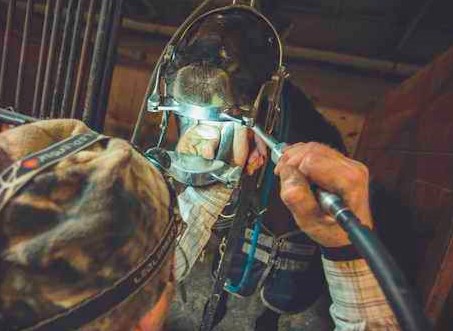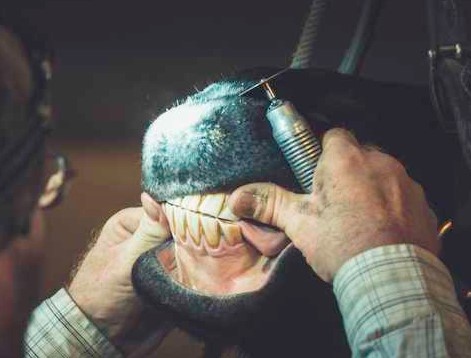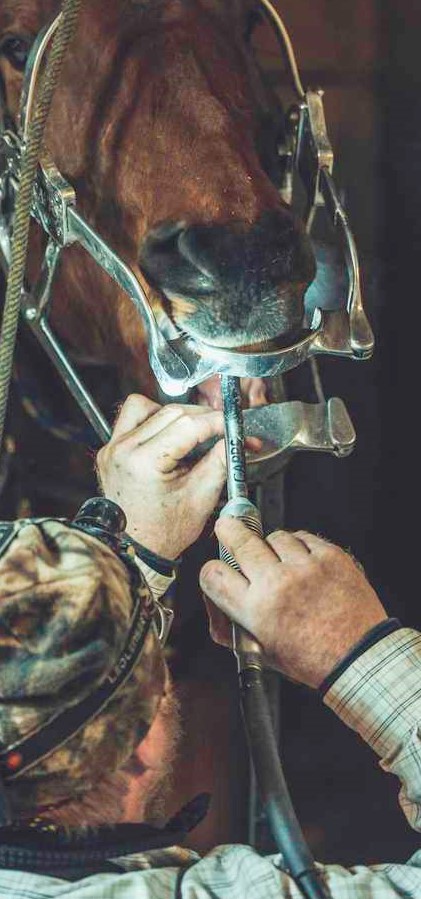Certification Criteria
 Certification Intent
Certification Intent
The goal of equilibration is to distribute the pressure and wear of mastication onto as many viable teeth as possible in order to maximize the longevity and integrity of the equine dentition. The reduction of ONLY the protuberant teeth allows the opposing excessively worn tooth room to erupt so that over time the amount of reserve crown is as symmetrical as possible for respective teeth. This will ensure an approximately even rate of wear on the respective teeth thus extending the viability and longevity of the dentition. During the process of equilibration, it is assumed that the sharp buccal and lingual points will be removed WITHOUT a functional loss of the occlusal surface.
The purpose of structure and guidelines is to define parameters within which equine dentistry can be performed. While the practical exam will test a basic understanding of the standard of routine dental maintenance it must be remembered that dentistry combines both the arts and sciences. To be performed at a high level, the practitioner must have a solid understanding of the hypsodont anatomy, geometrical physiology, biomechanics, and pathology combined with a knowledge of instrumentation and practical skills.
During the practical exam, the candidate must demonstrate their understanding of all the anatomical landmarks and variations that must be considered for each animal. This will be documented through charting of the horse following a thorough oral exam. Abnormal pathology must be completely documented. The horse should be given regular breaks with a complete closing of the speculum at regular intervals and rinsed during breaks.
Certification Testing Overview
CAEDP,Inc. shall provide a neutral testing location for participants to adequately demonstrate their equine dental knowledge and skill to be evaluated according to these Certification Procedures and shall be based on scientific research published in peer-reviewed journals worldwide.
Each candidate will have the opportunity to perform supervised dental procedures on a pre-screened testing horse. Work shall be evaluated by three CAEDP examiners independently.
Certification candidates should be prepared to identify dental malocclusions in multiple skull samples and tested on their proficiency of the following:
- Terminology
- Aging
- Anatomy
- Hypsodont Structure
- Principals of Mastication
- Dental Prophylaxis
 Certification Standards
Certification Standards
INCISORS:
- The incisors should not prevent or interfere with the lateral excursion or rostral-caudal movement of the mandible.
- The incisors should not displace the mandible from a neutral position.
- The incisor length should not prevent functional cheek teeth occlusion.
- The incisor table angle should be 3 to 8 degrees off the bars. The incisors should be evaluated prior to placement of the speculum. Excessive length should be reduced to eliminate additional discomfort when opening the speculum.
- When dental work is completed, the incisors should not be placing lateral pressure on the mandible.
- The incisors should be in contact with as many viable teeth as possible. It is understood that incisors that have been excessively worn may be left out of occlusion following the reduction of the protuberant opposing incisor. However, in cases where the incisors are well aligned, the pressure should be distributed onto as many teeth as possible.
- The incisors should feel free of mechanical restrictions during the lateral excursion.
- Incisor table angles should not be so steep that the rostral movement of the mandible is restricted.
- Complete flattening of the incisor table angle is not acceptable.
- During the equilibration of incisors, adequate techniques must be used to prevent excessive heat generation.
- Abnormal pathology such as EOTRH, necrotic pulp horns, fractures, periodontal disease, etc must be thoroughly documented on the chart.
CANINES:
- It is expected that the canine will be buffed and rounded but not overly reduced.
- Any tartar present should be removed.
- The presence of gingivitis should be charted accordingly.
- Blind canines should be elevated and well documented on the chart.
 CHEEK TEETH:
CHEEK TEETH:
- 100% occlusion of cheek teeth after correction is acceptable.
- Remove sharp points that may abrade soft tissue.
- Establish, restore or maintain optimally functional molar arcades by correcting malocclusions, while preserving maximum occlusal surface.
- Functional table angles should be restored and/or maintained.
- During the process of equilibration, it is assumed that the sharp buccal and lingual points will be removed WITHOUT a functional loss of occlusal surface.
- The occlusal surface should have as much width as possible without being sharp.
- The tooth opposing a protuberant tooth should always have a rough occlusal surface. Only the protuberant tooth may be reduced, and not the low opposing tooth.
- Proper technique must be used so that no unnecessary soft tissue damage occurs within the oral cavity.
- The occlusal surfaces should be balanced to the extent possible, but they should not be smooth. Only protuberant areas should be reduced.
- When the speculum is removed and the cheek teeth come together, the paired quadrants (100/400 and 200/300) should have simultaneous centric occlusion of as many viable cheek teeth as possible.
- “In occlusion excursion” for the purpose of testing is measured from the first point of contact during an excursion through to the point at which the most lateral point of the upper arcade is vertical to the lateral edge of the opposing arcade.
- The lateral excursion should be free and unrestricted.
- Low teeth that were excessively worn from protuberances may remain out of occlusion during the lateral excursion.
- Transitions between high and low teeth should be blended to allow for rostral/caudal movement of the mandible during mastication.
- During the practical exam, the candidate must demonstrate that he/she understands all the anatomical landmarks and variations that must be considered for each animal. This will be documented through charting of the horse following a thorough oral exam. Abnormal pathology must be completely documented. The horse should be given regular breaks with a complete closing of the speculum at about 5-minute intervals. The mouth should remain closed for at least 25-30 seconds and rinsed during breaks.
- Proper techniques and instruments must be used to minimize heat production from handpieces. This means using a precise approach to reducing protuberances.
- Any abnormal pathology such as necrotic open pulp horns, fractures, periodontal disease, infundibular caries, peripheral cemental caries, masses, etc must be thoroughly documented on the chart.
WOLF TEETH:
- Wolf teeth are to be extracted with the approval of the Certification Director Only.
BIT SEATS:
- The shape of the bit seat must not compromise the integrity of the tooth. Ideally, there should be minimal loss of functional occlusal surface.
- Finished bit seat should be smooth and uniform in shape.
Advanced Equine Dental Certification: The Advanced Certification Program will challenge participants to take both their knowledge and skills of the industry to the next level. Participants will be required:
- Deliver a professional 45 minute lecture (on a topic provided) at Basic Certification;
- Present an equilibration with complete narrative (to the group) from the explanation perspective “to the client”;
- Wetlab/Clinic Series and Basic Certification delivery assistance.

